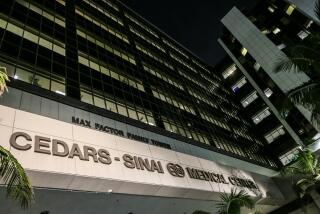Heart Care Study Reports Racial, Social Differences
- Share via
ANAHEIM — Low-income Los Angeles residents who seek emergency medical care for heart attack symptoms are more often Latino, female and younger compared to middle-income heart patients, USC Medical School researchers said here Wednesday.
Further, middle-income people suffering from cardiovascular disease decide sooner than their low-income counterparts to get professional medical attention, and are more likely to have received prior medical care.
These were among the findings of a study presented Wednesday at a panel discussion of racial differences in the incidence of coronary disease.
Kathleen Ell, a social work professor at USC and co-author of the study, said that “socioeconomic status seems to be more of a powerful influence than racial differences” in determining how quickly patients react to heart attack symptoms.
Dr. L. Julian Haywood, a USC professor of medicine, said the study was prompted by a review of 20 years of Los Angeles County death certificates showing that the highest mortality rate from heart disease was among blacks, followed by Caucasians, Latinos, Japanese, Chinese, Koreans and Filipinos.
Haywood was chief investigator in the $1-million study funded by the National Heart, Lung and Blood Institute.
Like other panelists at the American College of Cardiology’s annual convention in Anaheim, Haywood said he is convinced that socioeconomic factors, including public education and access to care, play a large role in heart illness.
Haywood said emergency room coronary patients were compared at the USC-Los Angeles County Hospital, which treats a high number of poor people, and at a Kaiser Permanente hospital in Hollywood that serves mostly middle-class working people.
Patients surveyed at each hospital, he said, included an equal number of Latinos, Caucasians and blacks.
The patients at the county hospital’s emergency room tended more often to be Latino females who smoke, have no regular sources of medical care and are six or seven years younger than the Kaiser patients. They also described their general health as poor.
The Kaiser patients, in contrast, Haywood said, “were more likely to be male, to be white, to have a history of angina, to know their cholesterol level, to have received estrogen therapy and to have a regular source of care, while reporting their general health status to be good.”
While black patients at USC delayed an average of almost 11 hours before going to the emergency room, more affluent black patients at Kaiser waited only seven hours.
The lower-income patients more often tried to take care of the symptoms themselves with over- the-counter or prescribed medications.
They were less likely to seek the advice of a physician and went to the hospital only after the symptoms, ranging from pain and shortness of breath to faintness, had become “overwhelming,” Ell said.
Other physicians on the panel reported studies in other parts of the country which showed that poor blacks, who run the highest risk of fatal heart attacks, frequently weren’t aware of the relationship of heart disease to hypertension, diabetes, high cholesterol levels and smoking.
Also, they were less likely than white heart attack victims to receive aggressive medical treatment for heart disease, such as coronary bypass surgery and catheterization.
More to Read
Sign up for Essential California
The most important California stories and recommendations in your inbox every morning.
You may occasionally receive promotional content from the Los Angeles Times.













